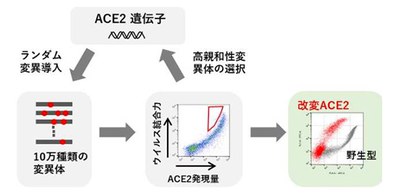
Promising neutralizing agent for coronavirus developed
A group of researchers from Kyoto Prefectural University of Medicine and the Institute for Protein Research and the Research Institute for Microbial Diseases of Osaka University has increased binding affinity of ACE2 to the SARS-CoV-2 spike receptor binding domain (RBD) up to ∼100-fold.
The SARS-CoV-2 spike protein binds to the human angiotensin-converting enzyme 2 (ACE2) receptor via RBD to enter into the cell. Since antibodies raised to the spike protein of SARS-CoV-1 can neutralize the virus by binding to the RBD and blocking binding to ACE2, antibody drugs are being developed as neutralizing agents. But there is a concern that most therapeutic antibodies lose effectiveness as new variants appear. To solve this persistent challenge, the group attempted to develop a SARS-CoV-2 neutralizing drug that has a high affinity by improving the binding affinity of ACE2 to the spike RBD.
The group conducted human cell-based directed evolution to improve the binding affinity of ACE2 to the spike RBD by error-prone PCR amplification of ACE2 protease domain. The researchers induced random mutations and generated a library of ∼105 mutants. By performing random mutagenesis screening for ACE2 residues 3 times, they achieved 100-fold higher affinity to RBD than wild-type ACE2.
Mammals have five classes of antibodies, also known as immunoglobulins, and the major class of antibodies in the blood is IgG. A typical antibody structure is Y-shaped and the tail is referred to as the Fc (fragment crystallizable) region and the Fab (fragment antigen-binding) regions. Binding affinity is measured by the equilibrium dissociation constant (KD), and the smaller the KD value, the greater the binding affinity of the ligand for its target. In experiments by this group, the KD value of wild-type (WT) soluble ACE2 (sACE2) to the SARS-CoV-2 spike RBD was 41.4nM, while that of modified ACE2 was 0.37nM.
The researchers formulated high affinity mutant sACE2s as human immunoglobulin G1 (IgG1) Fc fusion (ACE2-Fc) and evaluated their efficacy in neutralizing SARS-CoV-2 infections. Fusing sACE2 to the Fc region of the human IgG1 can enhance neutralization capacity and improve the pharmacokinetics to the level of IgG.
In addition, pseudotyped SARS-CoV-2 neutralization assay in ACE2-expressing 293T cells exhibited that IC50* values of 12.6μg/mL for wild type and 0.055μg/mL for modified type. Modified ACE2 fused to the human IgG1-Fc region neutralized SARS-CoV-2.
*IC50: The concentration of drug required for 50% inhibition
Using high affinity modified ACE2, this group, in cooperation with Life Science Institute, Inc., will develop COVID-19 drugs that have high neutralization capacity yet displaying resistance to escape mutations of virus. If such drugs are administered to people safely and the use of the drugs spreads, it will bring an end to the COVID-19 pandemic.
Figure 1
Figure 2
The article, “High affinity modified ACE2 receptors prevent SARS-CoV-2 infection,” was published in bioRxiv at DOI: https://www.biorxiv.org/content/10.1101/2020.09.16.299891v2.full.
Related links
